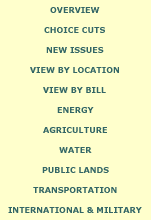
 |
 |
Issues >Agriculture
> Printer
Version $50 million
For
nearly seventy years, the federal government has spent hundreds of
millions of dollars to kill predators on the western range at the bequest
of livestock ranchers. Despite the tremendous decline in the western
livestock industry and the dramatic change in how scientists and the
public view predators today, the U.S. Department of Agriculture's Wildlife
Services (WS) program continues to kill tens of thousands of predators,
including bears, coyotes and wolves, each year at a cost to taxpayers of
more than $10 million. Green Scissors Proposal Current Status WS's operational budget for fiscal year 2001 is $36.7 million, $8 million more than the Clinton Administration recommended. The WS program also received funds from other federal agencies such as the Federal Aviation Administration and the U.S. Fish and Wildlife Service for cooperative projects such as the control of birds at airports and the protection of threatened and endangered species. On July 11, 2000, Representatives Peter DeFazio (D-OR), Charles Bass (R-NH) and Connie Morella (R-MD) offered an amendment to the fiscal year 2001 Agriculture Appropriations bill (H.R. 4461) that prohibited the expenditure of federal funds on lethal predator control. The amendment failed on a 190-228 vote. Senators Robert Smith (R-NH) and Barbara Boxer (D-CA) offered an
amendment that was incorporated into a manager's amendment. This amendment
appropriated $1 million for the WS program in order to create four pilot
projects to study non-lethal predator control methods in four
states. Ranchers are not required to pay for the assistance they receive from WS. This creates incentives for ranchers to use submarginal land and overgraze public lands. It also deters them from first attempting to correct predator losses on their own through methods that are more effective, such as improved animal husbandry practices. Taxpayers are subsidizing the approximately 10 percent of western ranchers who choose to use WS's livestock protection program. Further waste occurs because WS administrators have done a poor job of training their staff in using the non-lethal and more selective methods of predator control that have been developed by their research staff. Continuing to run the program in its traditional manner has proven
to be increasingly costly and has not resulted in any significant decline
in depredation rates. Program Hurts the Environment Due to over-reliance on lethal control methods, thousands of non-target species are killed annually, including rare, threatened and endangered species. Moreover, the amount of wildlife killed by WS has little relation to actual damage inflicted on crops or livestock. WS routinely kills predators in anticipation of potential losses, not just in response to confirmed damages. WS's activities make predator problems worse. Biologists have found that when subjected to intense control, not only do female coyotes respond by reproducing at an earlier age and producing larger litters, but pup survival increases, thereby rendering the control efforts counterproductive. The removal of large predators from an
ecosystem can result in a rise in species such as mice and rabbits, which
can cause millions of dollars in damage to crops and
rangelands.
|
|
|